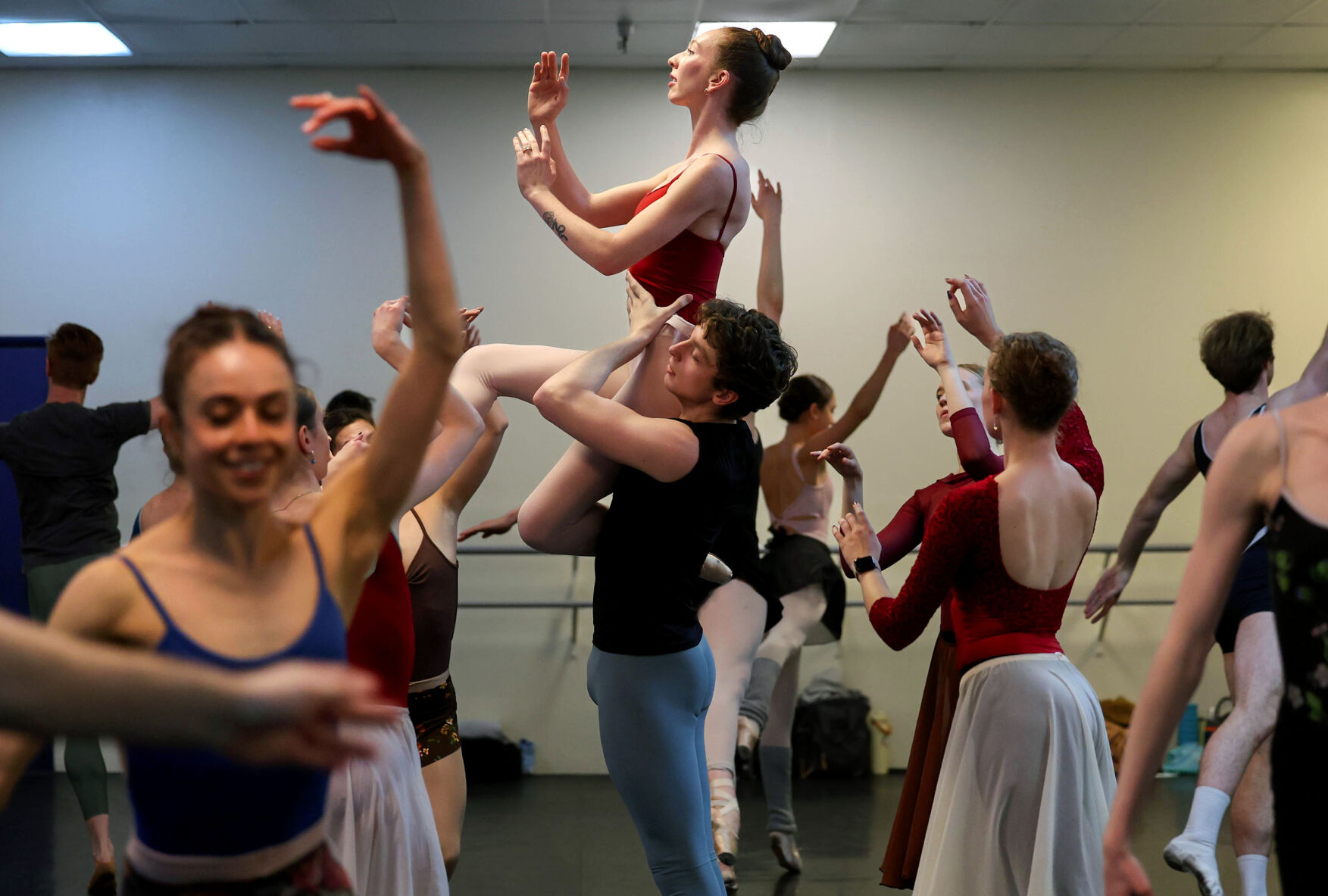When the Ballet Tucson dancers take the Leo Rich Theater stage for this weekend's "From Tucson With Love" concert, the irony of the setting will not be lost on choreographer Chieko Imada.
The Leo Rich sits smack in the middle of what used to be Tucson's culturally and historically rich barrio, the birthplace of legendary Tucson songwriter Lalo Guerrero.
Guerrero, the Father of Chicano music, is the inspiration of Imada's new work "Barrio Viejo," which is set to several of Guerrero's songs. The company will perform the world premiere four times between Friday, Feb. 14, and Sunday, Feb. 16, as part of the 13th annual Tucson Desert Song Festival.

Singer Lalo Guerrero sits in the lobby of Hotel Congress in 2002 as he promotes his memoir “Lalo, My Life and Music” with his co-author Sherilyn Meece Mentes.
Guerrero was born and grew up in the barrio and it was where he found inspiration for the seminal Chicano music that he created for more than six decades. The city bulldozed a big chunk of the barrio in the late 1960s in the name of urban renewal, displacing families that had lived there for generations and leveling businesses that once thrived along South Meyer Avenue.
"Barrio Viejo was such a special community back then," said Imada, who spent months researching the barrio and Guerrero, including consulting with his sons and walking around the community. "It is not the same as when Lalo used to live here and spent his childhood. There's so (much) life that was there, like an old store … (that) doesn't exist anymore. … The neighborhood was very close, and so it was really kind of a touching experience."

Charles Cronenwett, a member of the Corps de Ballet at Ballet Tucson, lifts Sarah Wilkerson during the rehearsal for "Barrio Viejo," a tribute to Lalo Guerrero's music, on Jan. 31.
In Imada's "Barrio Viejo," dancers dressed in 1940s zoot suits — wide-legged pants cuffed at the bottom, long suit coat with wide lapels — will stage a bar fight inspired by the 1981 movie “Zoot Suit” that featured several Guerrero songs.
For Guerrero’s famous ballad “Nunca Jamas,” Imada created a duet.
A couple also is the focus of an ensemble piece she created for Guerrero’s parody “There’s No Tortillas.” In the song, Guerrero professes his love for tortillas, especially corn tortillas, and how bread just won’t do.
Imada said she was really drawn to the song but wondered how she could set it in a dance. The song’s premise is a man “screaming about how he loves the tortilla and there's no tortilla … and he's so sad,” she said.

Edward Oyarce-Solomon, a soloist at Ballet Tucson, looks up to the sky after performing to "There's No Tortillas" during the rehearsal for "Barrio Viejo" on Jan. 31.
Imada came up with a kitchen scene where a wife tries to console her tortilla-loving husband with bread while corn dancers and tortilla dancers swirl about almost as a taunt. (We’ll be able to distinguish the corn and tortilla by their props.)
In addition to "Nunca James" and "There's No Tortillas," "Barrio Viejo" includes Guerrero's songs "Vamos a Bailar," "Los Chucos Suaves," "Dulce Madre" and his most iconic song, "Cancion Mexicana," largely considered Mexico's unofficial national anthem.

Naomi de Jesus, an apprentice at Ballet Tucson takes the hand of Edward Oyarce-Solomon during the rehearsal for "Barrio Viejo," on Jan. 31.
Tucson Guitar Society is collaborating with Ballet Tucson on the piece, which will feature the guitar trio of Misael Barraza Díaz, Diana Schaible and Andrés Pantoja and vocalist Carlos Zapién.
The guitar society and ballet have collaborated on several Tucson Desert Song Festival performances since the festival's inaugural year in 2013. For the last few years, Imada has created a new piece specifically for the festival including “Eternal Love — Songs of Edith Piaf” for the 2024 festival, featuring Tucson vocalist Katherine Byrnes and pianist Khris Dodge.
"I 100% believe that you shouldn't just have to live in Seattle or New York or Boston or travel to those places to be exposed to" great art, said Margaret Mullin, Ballet Tucson artistic director. "And certainly the song festival and the guitar society share that view that there's so much to celebrate locally. And collaborations locally are really special and exciting."
Mullin, who danced professionally in Seattle before coming home to Tucson in 2021 to work with Imada, choreographed the pas de deux from the balcony scene in Prokofiev's "Romeo & Juliet," the second work on the program.

Sarah Wilkerson dances with a large mesh cape during rehearsals for "Barrio Viejo" on Jan. 31.
"From Tucson With Love," which celebrates the 250th anniversary of Tucson's birth, opens with the company premiere of George Balanchine's "Rubies," set to music by Stravinsky. Performing anything from the Balanchine catalogue needs a license from the George Balanchine Trust, which requires applicants to demonstrate that they have the professional skills and artistic reputation to faithfully present the work, according to the trust.
"'Rubies' is one of Balanchine's most iconic ballets … and it's really a great honor to have a piece like this in our program, and to have a piece like this in our community," Mullin said. "We're trying to create a lot of really very special experiences for our patrons."
Ballet Tucson will perform "From Tucson With Love" at 7 p.m. Friday, 2 p.m. and 7 p.m. Saturday and 2 p.m. Sunday at Leo Rich Theater, 260 S. Church Ave. Tickets start at $34 through ballettucson.org.

A mural by Johanna Martinez featuring Lalo Guerrero can be seen at 600 S. Meyer Ave.








